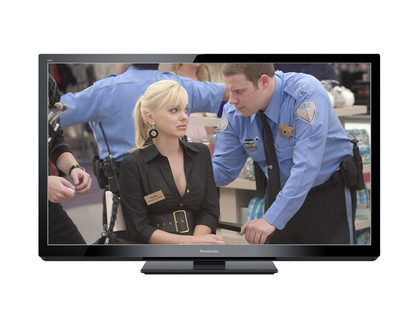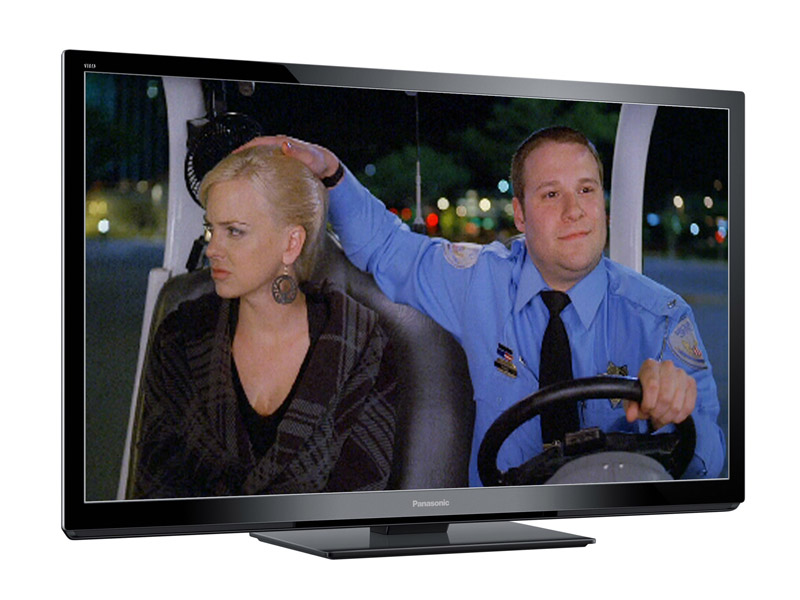Why you can trust TechRadar

The TX-P50GT30B knocks the aesthetic spots off previous Panasonic plasmas, with a cabinet that grows from a strikingly slender depth of 37mm to a reassuringly capacious 60mm where the speakers reside.
The whole screen feels extremely robust, as if it's been hewn from a block of metal. The bezel, in particular, is almost ridiculously sturdy, giving the TV a front-heavy posture that makes it quite difficult to handle when putting it upon its stand.
The bezel is narrow as well as slim and is given further appeal by the application of silver trim to both its inside and outside edges and a subtle, blended-in grey section in the centre of the TV's bottom edge.
The stuff going on inside the TX-P50GT30B is even more interesting. Panasonic's 3D NeoPlasma screens use a new phosphor with faster switching properties to boost the efficiency of the screen's illumination. Panasonic has also shrunk the 'rib' structure that divides the plasma cells, to boost luminance and has managed to increase brightness while reducing power consumption.
Perhaps most interesting of all is the new 'louver' (referring to overlapping slats) shape of the TX-P50GT30B's front filter, which both blocks more ambient light from hitting the screen and absorbs more of whatever remains to deliver an impressive claimed contrast boost of up to 40 per cent.
The TX-P50GT30B's connectivity follows the lead of the TX-L32DT30B, which is good news for the most part. Four HDMIs deliver digital HD and active 3D images, while a LAN port, three USBs, an SD card slot and a D-Sub PC port serve the TV's extensive multimedia abilities.
The LAN port is particularly handy to most modern households, as it enables you either to access content on your DLNA PC or to delve into Panasonic's reasonably extensive new Viera Connect online service.
The USBs and SD card slot are predominantly there to provide instant access to video, photo and music files held on portable storage devices, but the former can also be used either to record – losslessly – from the Freeview or Freesat digital tuners to a powered hard-disk drive drive, or to make the set Wi-Fi-enabled via an optional dongle.
Heading into the TX-P50GT30B's onscreen menus, you'll find that the screen has two endorsements. First, there's a THX mode among the picture presets that extends to 3D playback.
Second, if you head into the Setup menu, you'll see an Advanced (isfcc) option. Activate this then head back to the picture preset options and you'll find two additional Professional slots where an ISF engineer can store day and night image settings.
After activating the Advanced option you'll also be able to access a series of gamma settings and a white balance toolset enabling you to tweak the gain and cut-off levels of the red, green and blue colour elements. There's no way to adjust the secondary (cyan, magenta and yellow) components, though.
Other features of note include Panasonic's 600Hz Sub-field drive technology for making the image look smoother and richer and the brand's Intelligent Frame Creation (IFC) system, which interpolates extra frames of image data to remove judder. This morphs into 24p Smooth Film when watching Blu-rays.
When it comes to 3D, there's 2D-3D conversion, a new 'auto detect' option that can spot and respond to side-by-side 3D broadcasts such as those delivered by Sky and the option to adjust the field-depth of 3D images. Bear in mind, though, that exploring the latter tool might result in messing about with depth that has been already been carefully and deliberately set by a 3D source.
Two potentially alarming final adjustments are a pixel orbiter and a screen wipe. These are both designed to tackle plasma's problems with image retention, even though recent experience with Panasonic plasma TVs suggests that such tools are no longer essential.
Viera Connect wraps up the features section; this has already been covered in other reviews of new Panasonic sets, but to save you a spot of cross referencing, its key points are that it's a cloud-based, apps-driven system containing dozens of video, game, music and information apps for you to download if you fancy them.
Highlights include the BBC iPlayer (a long overdue addition to Panasonic's online offering), Skype, YouTube, the Acetrax movie rental/purchase service, and upcoming games and fitness programmes that will work with new optional hardware accessories including a joystick, a pulse-rate monitor, and even a treadmill.
Current page: Panasonic TX-P50GT30B: Features
Prev Page Panasonic TX-P50GT30B: Overview Next Page Panasonic TX-P50GT30B: Picture qualityJohn has been writing about home entertainment technology for more than two decades - an especially impressive feat considering he still claims to only be 35 years old (yeah, right). In that time he’s reviewed hundreds if not thousands of TVs, projectors and speakers, and spent frankly far too long sitting by himself in a dark room.

